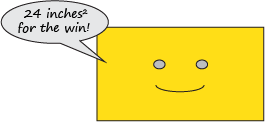There are a whole bunch of different shapes in geometry. At this point, that should be fairly obvious. If there weren't different shapes, you wouldn't be reading this right now.
But the sad truth is that you are, and you have circles, triangles, and quadrilaterals to thank for that. Euclid, Pythagoras, and the rest of those ancient Greeks aren't exactly innocent, either, but they did give us democracy and theatre and yogurt, so they can't be that bad.
As you've learned, each shape has its own particular properties. Each one is special and unique, like a snowflake or a flu virus. Luckily, all 2D shapes share one unifying characteristic: area. Granted, calculating the area is different for each shape, but it doesn't change the fact that every two-dimensional shape has an area.
So what is area and why do we care about it? Area is the amount of space within the boundaries of a two-dimensional shape. You can think of area as the amount of paint needed to cover a particular 2D space.
Let's say Vincent Van Gogh is willing to pay you $100 to paint his wall. With all the paintings he's working on, he can't be bothered with trivial wall painting. It's beneath him. Anyway, the $100 offer may or may not be a good one, depending on how big that wall is.
How much room is there between the boundaries of the ceiling, floor, and the two edges of the wall? How much wall do you actually need to paint? What is the wall's area? All three questions ask the same thing. And you may or may not take Van Gogh up on his offer, depending on the answer.

Imagine you're trying to explain the game of football to your friend from Spain, and she asks, "Football? Do you mean fútbol? Oh wait, that's soccer. So how big is a football field compared to a fútbol field?" In mathematical terms, your friend is asking you to compare the areas of the two fields. You can do it. ¡Sí, se puede!
Sample Problem
Is it possible to calculate the area of a line?
Nope. Like we said before, area is two-dimensional, which means we need a closed 2D shape. A line is neither a shape nor two-dimensional. We can calculate the length of a line (though a true line is infinitely long), but not area.
For you visual learners out there, fear not. Here's a visual example.
This is a rectangle. Say hello.

Let's say the rectangle has an area of 24 inches2. That means that the shaded area within the border totals 24 inches2.

Hold up. Inches2? Does the 2 mean a footnote or something?
No, no. Let's be real. We know that the chances of anyone reading a footnote are slim to none. The "2" represents "squared." (Yes, we know the shape is a rectangle and not a square. Don't get your panties in a bunch.) By "squared," we mean, "raised to the power of two."
Why? We're glad we asked. Area is a two-dimensional unit of measure. When calculating area, make sure the units of the shape are consistent. If we measure one side of the rectangle in inches and the other side in feet, we'll end up with some funky-looking units. It's best to make them either inches or feet so that our units will ultimately be either in2 or ft2.
Sample Problem
A triangle's measurements are in units of meters. What units will its area be in?
Remember, area is a two-dimensional unit, which means that our final answer will be in square units. In this case, since the triangle's measurements are in meters, its area will be in units of square meters, or m2.
Also consider that units of area have to be squared units of distance. Gram (mass) and liters (volume), even if they're squared, aren't units for area.
But what about the numbers? What does area actually mean for any given shape? And how do we go about finding it?
Don't worry your pretty little head. We'll discuss ways to calculate area for triangles, quadrilaterals, and circles. In the end, you'll know whether Van Gogh is trying to rip you off with that wall-painting offer. Though you could just follow in the footsteps of Tom Sawyer and get others to do it for you. Van Gogh will never see (or, unfortunately, hear) it coming.
Example 1
Can the area of a pentagon be calculated? |
Example 2
The measurements of a circle are expressed in kilometers. Can we find the area? If so, what units will we use? |
Example 3
A regular dodecagon (12-sided figure) has side lengths of 8 mm. What units will its area be in? |
Example 4
If two polygons are congruent, their areas are congruent. True or false? |
Exercise 1
Can the area of a hexagon be calculated?
Exercise 2
Can the area of a cube be calculated?
Exercise 3
Why is grams2 not a valid unit for area?
Exercise 4
From the list in3, kg2, cm2, mL2, units, light-years2, min2, ft, yd2, and miles2, which are valid units for area?
Exercise 5
From the list ft2, sec, units2, in, cm3, km-1, mg2, mm2, lb2, oz2, and meters, which are valid units for area?